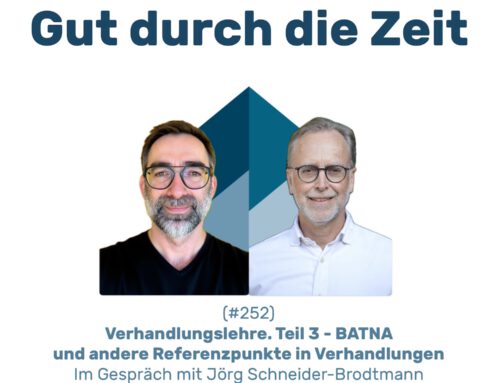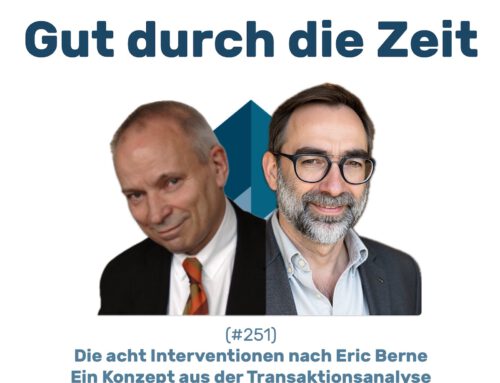Business moderation – 10 considerations for moderation
To conclude this small series of tips and suggestions for facilitating group discussions, which began with 10+1 commandments and continued with 10 prohibitions and 10 recommendations, I would like to conclude this topic with 10 Considerations finalise.
These are intended to be basic considerations on moderation, the practical effects of which will probably vary depending on the industry, the occasion and the group and organisational culture, but will hopefully always remain helpful.
I would be delighted to receive brief feedback on this and the series as a whole!
Blog post series on moderation
1. separation of management and moderation
For a long time, I considered to what extent I should not formulate the personal distribution of the roles of leadership and moderation as a requirement. I was simply put off by the existing tradition that leadership and moderation competences are often seen as identical. I can spare myself an imperative that would smash against the wall of culture.
But as a consideration, the idea may have a chance. So right at the beginning.
If the group leader also takes responsibility for the group process (moderation!) in difficult decision-making and discussion rounds, they weaken both their leadership authority and the potential power of moderation for the group.
When moderating the contributions to the discussion, the leader will always be suspected of steering the process in their own favour. As a result, the group will neither be able to build trust in the moderator nor experience the full persuasive power of their leader.
Rather, it is worth considering breaking down the complexity of the group's internal structure in order to do justice to the more complex external demands that put pressure on the group. Or in short: the separation of the roles of "leadership" and "moderation" should also be made clear in terms of personnel. In this way, the leader can contribute to the content and argue freely in discussions, while the moderator can concentrate on moderating.
ConsequencesInstall moderation in meetings alongside the chairperson, give them all the "process powers" to steer the meeting, always lead to the topic, stop digressions and monologues, calm down steamy chatterboxes, restrain the eloquent and encourage the silent.
2. service
As already recommended, participants are also customers for the moderator. A service is provided for them, as facilitation serves the group in its work process. As customers, group participants want things to be as simple as possible. The meeting should be simple. If it is simple, the participants can do their work well. They can think, consider, decide. They don't have to worry, fight, wrestle.
Possible ConsequencesPreparation requires information, but not data and information waste. Prepare information appropriately. Pay attention to the physical well-being, the content of the breaks, so to speak. Write favourably, large and legibly if you are using handwriting (e.g. with the Metaplan method). When it comes to service, the little things are important and decisive.
3. distraction
What's not to get excited about the new things, smartphones, mobile phones, laptops should be banned from meetings. Sometimes you will too!
- Example from Switzerland
- Particularly controversial in works council committees!
- https://www.udldigital.de/handys-im-meeting-ok-oder-no-go/
It is clear that not every meeting can be a blockbuster, a firework display of entertainment, but distraction tools are always a signal and feedback for the moderator (and leader): perhaps the problem is being tackled methodically in the wrong way, perhaps the wrong problem is being worked on or even the right solution has been talked away for a long time. The level of attention or distraction is also a helpful measuring instrument for the moderator. It is simply stupid for the moderator to ignore this instrument. really got rid of, right?
4. volume
I've been told for years that I speak too quietly. In strategic dialogues and workshops as well as in training courses and seminars, people can hardly understand me. That's probably true. And often not only in terms of volume, but also in terms of content. But that's another matter...
What is important for me is the experience that my quiet speech attracts attention. Groups quickly become quiet when I start talking. I don't have to get loud at all. Starting quietly is often enough (for me?). It's a paradox, but it's a real experience.
ConsequenceTry quiet sounds when you want to be the loudest!
5. visualisation with beamer
If it has to be a projector for the PowerPoint presentation, then at least one that can be used in daylight and sunlight. No one needs darkened cinema rooms for group meetings any more!
ConsequencesProjectors that can be used in daylight are rare and often too expensive. So, just leave the PPP out of the session (Also the 5th prohibition ).
6. joint visualisation
Kanban, but also the good old metaplan method, invite everyone in the group to (be able to) visualise the joint considerations and work results. In this respect, it is not one person who embodies the group process, but everyone together. This can sometimes work (stand-up meetings with Kanban visualisation), but it can also lead to chaos.
ConsequencesDefine the problem: Which problem should be solved with the joint visualisation. Then test it out and introduce it permanently if necessary.
Photo by Tim Gouw on Unsplash
7. digital pauses
Many still consider digitally-driven communication to be an evil of our time, which prevents „honest“, direct communication between people and makes people lonely. I personally think that's rubbish, but that's another topic.
The key consideration is that the individual members of a working group, as communicative beings, are exposed to the pressure of the group as well as a multitude of other private, social and professional communication partners with whom they are in contact via digital channels - even during the meeting. Children and spouses send and receive, emails and text messages want to be answered, tradespeople and service providers get in touch, friends and work colleagues make contact, want to have or get rid of information, press further projects. And - shopping must also be done. In short: meetings do not take place in socially sanitised rooms. Meetings have a context that needs to be considered if you want to have true contributors as a facilitator.
ConsequenceIt is worth considering the extent to which digital breaks are scheduled, which should not be longer than 5(!) and in which the participants use the time to "check" the most important channels for the most important information flows. The bottleneck here is likely to be sticking to the break times and holding some learning potential. Nevertheless, since it is happening anyway, it is worth making a mutually acceptable agreement that is more likely to be adhered to than directives.
8. attacks
Every moderator has experienced attacks on their way of working. They are quickly taken personally and are often meant as such. They can affect compliance with democratic rules as well as professional behaviour or the choice of methods.
ConsequenceHowever, it is always worth looking more closely for the "good core" in attacks. It is not uncommon for crude attacks to simply be innocent requests, blustering but essentially justified personal concerns, whose form simply makes it difficult to listen.
Example: "It doesn't work the way you mean it!"...It's not worth jumping on whether the participant has actually grasped what you meant. This discussion is unprofessional. Justifying what you meant does not help the group. Instead, follow the common search track for how "it" could work for all of you: "Good, then I think it makes sense to talk about how it could work for us.".
9. conflicts
Meetings harbour enormous potential for conflict, especially if they are perceived as useless and a waste of time. Dosed escalations of conflict can bring a bit of vigour to the meeting and increase physical well-being. Adrenalin first. Keyword: Drama triangle.
After all, conflicts harbour enormous energy potential for those involved and a great deal of commitment to the cause. Utilise this commitment and channel it into meaningful channels with the help of constructive redefinition. After all, not every disagreement in a meeting has to be immediately contained in formal mediation.
10. decisions
In meetings with different hierarchical levels, but also in project teams, it is not always appropriate to make decisions on a democratic basis. A group that wants to make decisions must always decide how it will reach its group decision.
Here, groups and their leaders move around the Leadership continuumwhich can be broken down into around seven levels.
ConsequenceUse the game "delegation poker" to introduce more participation. Each participant receives cards with the numbers 1 to 7. When asked to decide at which level the group should make a particular decision, each participant chooses a level. Face down or face up. Cultural question.
If the levels (numbers) are more than two units apart, the consequences for the group or the management are discussed. Then another round of poker to decide at which level the team would like to make the decision.
The purpose of delegation poker is not to assign the group decision to the poker randomness, but to make the dynamics of the group discussable. Grassroots democracy or the power decision is not always appropriate for all decisions. Even the shades can be assessed differently. Delegation poker hands over the meta-decision to the group and encourages dialogue. In this way, a common itinerary becomes recognisable, to what extent the participants reflect on authority and democracy and comment on their decision-making processes.







Leave A Comment